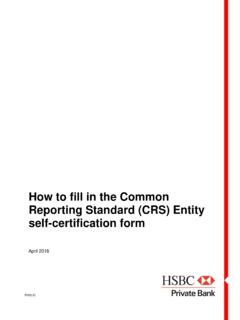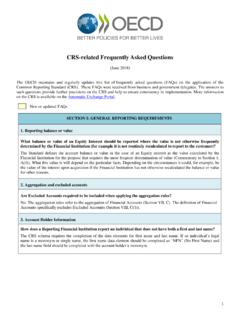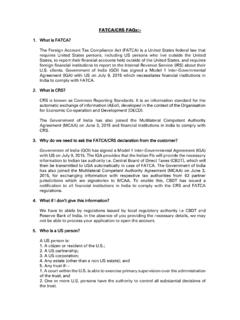Transcription of Country-by-Country Reporting XML Schema - OECD
1 Country-by-Country Reporting XML Schema : User Guide for Tax Administrations Version June 2019 PUBE This document and related XML Schema , as well as any data and any map included herein, are without prejudice to the status of or sovereignty over any territory, to the delimitation of international frontiers and boundaries and to the name of any territory, city or area. This document was approved by the Committee on Fiscal Affairs on 5 April 2019 and prepared for publication by the OECD Secretariat. Please cite this publication as: OECD (2019), Country-by-Country Reporting XML Schema : User Guide for Tax Administrations, Version June 2019, OECD, Paris. The statistical data for Israel are supplied by and under the responsibility of the relevant Israeli authorities. The use of such data by the OECD is without prejudice to the status of the Golan Heights, East Jerusalem and Israeli settlements in the West Bank under the terms of international law.
2 Note by Turkey The information in the related XML Schema with reference to Cyprus relates to the southern part of the Island. There is no single authority representing both Turkish and Greek Cypriot people on the Island. Turkey recognises the Turkish Republic of Northern Cyprus (TRNC). Until a lasting and equitable solution is found within the context of the United Nations, Turkey shall preserve its position concerning the Cyprus issue . Note by all the European Union Member States of the OECD and the European Union The Republic of Cyprus is recognised by all members of the United Nations with the exception of Turkey. The information in the related XML Schema relates to the area under the effective control of the Government of the Republic of Cyprus. Photo credits: Cover OECD 2019 You can copy, download or print OECD content for your own use, and you can include excerpts from OECD publications, databases and multimedia products in your own documents, presentations, blogs, websites and teaching materials, provided that suitable acknowledgement of OECD as source and copyright owner is given.
3 All requests for public or commercial use and translation rights should be submitted to Country-by-Country Reporting XML Schema : USER GUIDE FOR TAX ADMINISTRATIONS OECD 2019 INTRODUCTION 3 IntroductionAction 13 of the OECD s Action Plan on Base Erosion and Profit Shifting (BEPS) requires the development of rules regarding transfer pricing documentation to enhance transparency for tax administration, taking into consideration the compliance costs for business. The rules to be developed will include a requirement that MNEs provide all relevant governments with needed information on their global allocation of the income, economic activity and taxes paid among countries according to a common template .In response to this requirement, a three-tiered standardised approach to transfer pricing documentation has been developed, including the requirement for MNEs with annual consolidated group revenue equal or exceeding EUR 750 million (or an approximately equivalent amount in domestic currency) to file a Country-by-Country (CbC) Report that will provide annually and for each Tax Jurisdiction in which they do business the amount of revenue, profit before income tax and income tax paid and accrued.
4 It also requires MNEs to report their number of employees, stated capital, accumulated earnings and tangible assets in each Tax Jurisdiction. Finally, it requires MNEs to identify each entity within the group doing business in a particular Tax Jurisdiction and to provide an indication of the business activities each Constituent entity engages in. The approved template for CbC Reports can be found in Appendix Reports should be filed in the Tax Jurisdiction of the Reporting entity and shared between jurisdictions through automatic exchange of information, pursuant to government-to-government mechanisms such as the Multilateral Convention on Mutual Administrative Assistance in Tax Matters, Double Tax Conventions or Tax Information Exchange Agreements (TIEAs). In limited circumstances, secondary mechanisms, including local filing can be used as a order to facilitate the swift and uniform implementation of CbC Reporting and with a view to accommodating the electronic preparation, filing and exchange of CbC Reports, the present CbC XML Schema and the related User Guide have been Schema is a data structure for electronically holding and transmitting information.
5 XML, extensible markup language , is commonly used for this purpose. Examples are the OECD s common Reporting Standard XML Schema , the United States FATCA XML Schema and the European Union s Fisc 153 User Guide explains the information required to be included in each CbC data element to be reported in the CbC XML Schema v. It also contains guidance on how to make corrections of data items within a file that can be processed definition of all capitalised terms used in this User Guide can be found in the final report on BEPS Action Reporting XML Schema : USER GUIDE FOR TAX ADMINISTRATIONS OECD 2019 TABLE OF CONTENTS 5 Table of contentsIntroduction 3 How the CbC User Guide links to the CbC XML Schema ..7 CbC XML Schema Information.
6 9 CbC Correction examples..28 Appendix A. CbC XML Schema V2 0 Diagrams ..37 Appendix B. Glossary of namespaces..43 Appendix C. Template for the Country-by-Country Report ..44 Country-by-Country Reporting XML Schema : USER GUIDE FOR TAX ADMINISTRATIONS OECD 2019 HOw THE CBC USER GUIDE LINkS TO THE CBC XML Schema 7 How the CbC User Guide links to the CbC XML SchemaThis User Guide is divided into logical sections based on the Schema and provides information on specific data elements and any attributes that describe that data Country-by-Country Reporting XML Schema Information sections are:I. Message Header with the sender, recipient, message type, Reporting periodII. The identifying information to be provided for each Constituent EntityIII. The body of the CbC XML Schema , containing the reportable information on the Reporting entity and each Constituent entity , as well as a summary of the activities of the MNE Group, as set out in the CbC Reporting CbC XML Schema is designed to be used for the automatic exchange of CbC Reports between Competent Authorities.
7 In addition, the CbC XML Schema may also be used for domestic Reporting by Reporting Entities to their domestic tax authorities. Items relevant for domestic Reporting only are shown in [brackets].The requirement field for each data element and its attribute indicates whether the element is validation or optional in the CbC XML Schema . Validation elements MUST be present for ALL data records in a file and an automated validation check can be undertaken. The sender should do a technical check of the data file content using XML tools to make sure all validation elements are present and, if they are not, a correction to the file should be made. The receiver may also check the presence of all validation elements and may reject the file in case such elements are missing. Some elements are shown as (Optional) Mandatory , indicating they are in principle required for CbC Reporting , but only in certain instances, as further specified for the respective elements in this User Guide.
8 Consequently, (Optional) Mandatory elements may be present in most (but not all) circumstances, so there cannot be a simple IT validation process to check these. For example, the Reporting entity and CbC Reports elements are labelled as Optional (Mandatory) , indicating that both elements are in principle mandatory, unless one of the elements is left blank in the context of a correction of the other element (see the Corrections section below for further detail). Other Optional elements are, while recommended, not required to be provided and may in certain instances represent a choice between one type or another, where one of them must be used ( choice between address fix or address free).Sections V, VI and VII of the CbC User Guide contain further guidance on the Schema version, transliteration of information and corrections, A to the CbC User Guide shows a diagrammatic representation of the CbC XML Schema with all its elements.
9 The numbers next to the headings are the corresponding section numbers in the User Guide text, which provides further guidance on the information to be provided in each B to the CbC User Guide contains a glossary of namespaces for the CbC XML Reporting XML Schema : USER GUIDE FOR TAX ADMINISTRATIONS OECD 2019 CBC XML Schema INFORMATION 9 CbC XML Schema InformationI Message HeaderInformation in the message header identifies the Competent Authority that is sending the message, as well as the Competent Authorities receiving the message. It specifies when the message was created, what period (normally a fiscal year) the report is for, and the nature of the report (original, corrected, supplemental, etc.).ElementAttributeSizeInput TypeRequirementSendingEntityIN1 to 200 charactersstf:StringMin1 Max200_TypeOptional[Although not used for exchanges between Competent Authorities in the context of CbC Reporting , the Sending entity IN element would be mandatory for domestic Reporting and would identify the Reporting entity Reporting to the sending Competent Authority ( by a domestic TIN or IN).]
10 ]ElementAttributeSizeInput TypeRequirementTransmittingCountry2-char acteriso:CountryCode_TypeValidationThis data element identifies the jurisdiction of the Competent Authority transmitting the message. It uses the 2-character alphabetic country code and country name list based on the ISO 3166-1 Alpha 2 standard, complemented by the X5 code for stateless entities and [For domestic Reporting this element would be the domestic country code .]ElementAttributeSizeInput TypeRequirementReceivingCountry2-charact eriso:CountryCode_TypeValidationThis data element identifies the jurisdiction(s) of the Competent Authority or Authorities that is(are) the intended recipient(s) of the the context of CbC Reporting , all jurisdictions in which a Constituent entity is found to be resident on the basis of the information provided by the Reporting entity in the CbC Report should be entered in this field.
















